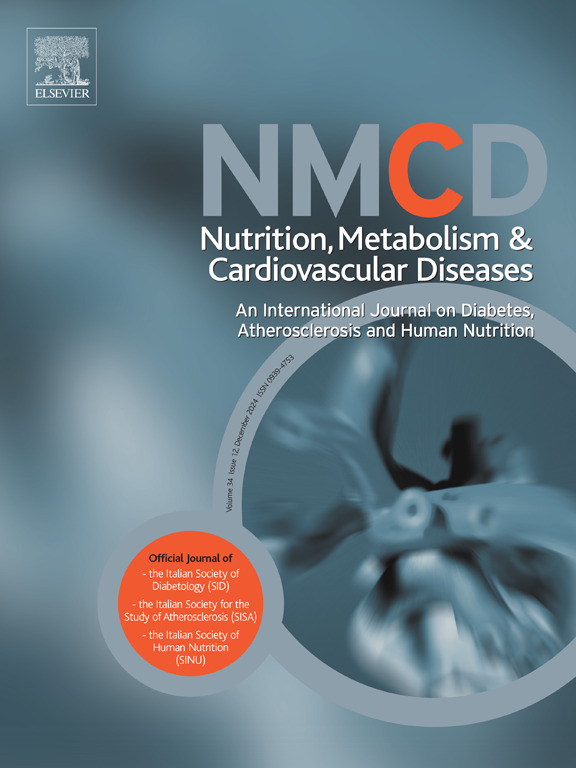Serum klotho concentration, vitamin D concentration and cardiovascular diseases risk: Evidence from the NHANES database 2007–2016
IF 3.3
3区 医学
Q2 CARDIAC & CARDIOVASCULAR SYSTEMS
Nutrition Metabolism and Cardiovascular Diseases
Pub Date : 2025-02-05
DOI:10.1016/j.numecd.2025.103905
引用次数: 0
Abstract
Background and aim
Epidemiologic studies have shown that serum vitamin D (VD) deficiency is associated with an increased risk of cardiovascular diseases (CVDs) and CVDs-mortality. Klotho is a well-recognized anti-aging protein. However, it is limited understanding the role of Klotho on the association of serum VD and CVDs risk. This study aimed to explore the role of serum Klotho on the association between serum VD and CVDs risk.
Methods and results
Totally 12,634 subjects were included from NHANES (2007–2016), of whom 1365 (10.80 %) had CVDs. Subjects were divided into serum VD deficient group sufficient group with the cutoff value of 50 nmol/L. Serum Klotho concentrations were detected by ELISA kit. Weighted univariate and multivariate were utilized to explore the association of serum Klotho, serum VD and CVDs risk, with odds ratios (ORs) and 95 % confidence intervals (CIs). Subjects with deficient serum VD had a 56 % increase in CVDs risk (OR = 1.56, 95%CI: 1.21–2.00); subjects with deficient serum VD and low serum Klotho have the highest CVDs risk (OR = 1.58, 95%CI: 1.19–2.11). We further found the association of low serum VD and CVDs risk was only observed in low serum Klotho concentration (OR = 1.74, 95%CI: 1.27–2.39), these results suggested serum Klotho concentration play a moderating effect on the association of serum VD concentration and CVDs risk. The results of subgroup analyses suggested these moderating effects were more prominent in subjects with overweight/obese (OR = 1.85, 9 %%CI: 1.25–2.72), and with the history of hypertension (OR = 1.87, 9 %%CI: 1.32–2.65) and dyslipidemia (OR = 1.81, 95%CI: 1.32–2.49).
Conclusions
Low serum VD was associated with high CVDs risk and high serum Klotho may play a moderating effect on the association between serum VD and CVDs risk.
血清klotho浓度、维生素D浓度与心血管疾病风险:来自NHANES数据库2007-2016的证据
背景和目的:流行病学研究表明,血清维生素 D(VD)缺乏与心血管疾病(CVD)和 CVD 死亡风险的增加有关。Klotho 是一种公认的抗衰老蛋白。然而,人们对 Klotho 在血清维生素 D 与心血管疾病风险相关性中的作用了解有限。本研究旨在探讨血清 Klotho 对血清 VD 与心血管疾病风险之间关联的作用:研究共纳入了12634名来自NHANES(2007-2016年)的受试者,其中1365人(10.80%)患有心血管疾病。受试者被分为血清VD缺乏组和血清VD充足组,临界值为50 nmol/L。血清 Klotho 浓度通过 ELISA 试剂盒检测。利用加权单变量和多变量探讨血清Klotho、血清VD与心血管疾病风险的相关性,并得出几率比(ORs)和95%置信区间(CIs)。血清 VD 缺乏的受试者患心血管疾病的风险增加了 56%(OR = 1.56,95%CI:1.21-2.00);血清 VD 缺乏且血清 Klotho 含量低的受试者患心血管疾病的风险最高(OR = 1.58,95%CI:1.19-2.11)。我们进一步发现,只有在血清 Klotho 浓度较低时,才能观察到低血清 VD 与心血管疾病风险的相关性(OR = 1.74,95%CI:1.27-2.39),这些结果表明血清 Klotho 浓度对血清 VD 浓度与心血管疾病风险的相关性起着调节作用。亚组分析结果表明,这些调节作用在超重/肥胖(OR = 1.85,9%CI:1.25-2.72)、有高血压病史(OR = 1.87,9%CI:1.32-2.65)和血脂异常(OR = 1.81,95%CI:1.32-2.49)的受试者中更为突出:低血清VD与高心血管疾病风险相关,而高血清Klotho可能对血清VD与心血管疾病风险之间的关联起到调节作用。
本文章由计算机程序翻译,如有差异,请以英文原文为准。
求助全文
约1分钟内获得全文
求助全文
来源期刊
CiteScore
6.80
自引率
2.60%
发文量
332
审稿时长
57 days
期刊介绍:
Nutrition, Metabolism & Cardiovascular Diseases is a forum designed to focus on the powerful interplay between nutritional and metabolic alterations, and cardiovascular disorders. It aims to be a highly qualified tool to help refine strategies against the nutrition-related epidemics of metabolic and cardiovascular diseases. By presenting original clinical and experimental findings, it introduces readers and authors into a rapidly developing area of clinical and preventive medicine, including also vascular biology. Of particular concern are the origins, the mechanisms and the means to prevent and control diabetes, atherosclerosis, hypertension, and other nutrition-related diseases.

 求助内容:
求助内容: 应助结果提醒方式:
应助结果提醒方式:


